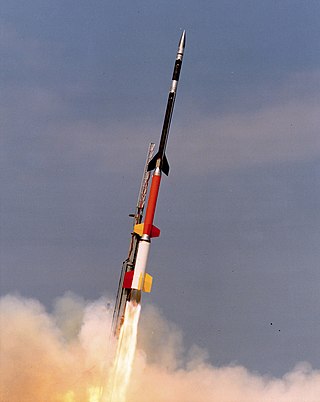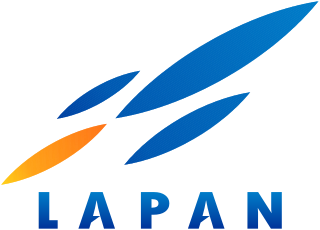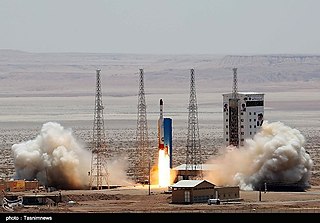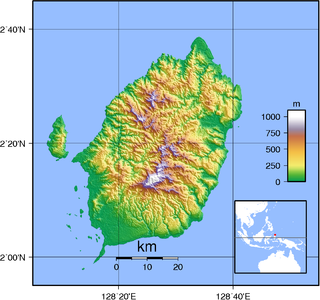Related Research Articles

A sounding rocket or rocketsonde, sometimes called a research rocket or a suborbital rocket, is an instrument-carrying rocket designed to take measurements and perform scientific experiments during its sub-orbital flight. The rockets are used to launch instruments from 48 to 145 km above the surface of the Earth, the altitude generally between weather balloons and satellites; the maximum altitude for balloons is about 40 km and the minimum for satellites is approximately 121 km. Certain sounding rockets have an apogee between 1,000 and 1,500 km, such as the Black Brant X and XII, which is the maximum apogee of their class. Sounding rockets often use military surplus rocket motors. NASA routinely flies the Terrier Mk 70 boosted Improved Orion, lifting 270–450-kg (600–1,000-pound) payloads into the exoatmospheric region between 97 and 201 km.

Pinaka is a multiple rocket launcher produced in India and developed by the Defence Research and Development Organisation (DRDO) for the Indian Army. The system has a maximum range of 40 km for Mark-I and 60 km for Mark-I enhanced version, and can fire a salvo of 12 HE rockets in 44 seconds. The system is mounted on a Tatra truck for mobility. Pinaka saw service during the Kargil War, where it was successful in neutralising Pakistani positions on the mountain tops. It has since been inducted into the Indian Army in large numbers.

Stasiun Peluncuran Roket or Staspro is a rocket launch site managed by the Indonesian National Institute of Aeronautics and Space (LAPAN). It is located at Pameungpeuk Beach in the Garut Regency on West Java near Cilautereun and has been active since 1965 to perform engine tests and launch sounding rockets.

The Launch Vehicle Mark-3 or LVM3 is a three-stage medium-lift launch vehicle developed by the Indian Space Research Organisation (ISRO). Primarily designed to launch communication satellites into geostationary orbit, it is also due to launch crewed missions under the Indian Human Spaceflight Programme. LVM3 has a higher payload capacity than its predecessor, GSLV.

The National Institute of Aeronautics and Space was the Indonesian government's space agency. It was established on 27 November 1963, by former Indonesian president Sukarno, after one year's existence of a previous, informal space agency organization. LAPAN is responsible for long-term civilian and military aerospace research.
Satellite Orbiting Rocket Number 420, or Pengorbitan-1, was a proposed space launch vehicle under consideration in Indonesia from 2008 to 2012. Recent developments have focused on a larger core stage called RX-420 and a smaller upper stage called RX-320. Therefore, this particular version RPS-420 is no longer being pursued. However, the goal remains valid: Indonesia aims to reach orbit with self-made rockets and satellites in order to become an Asian space power.

Simorgh, also called Safir-2, is an Iranian expendable launch vehicle under development. It is the successor of the Safir, Iran's first space launch vehicle. Its mission is to carry heavier satellites into higher orbit than Safir.

Progress M-08M, identified by NASA as Progress 40P, is a Progress spacecraft which was used to resupply the International Space Station. It was the eighth Progress-M 11F615A60 spacecraft to be launched, the fifth for the year 2010. The spacecraft was manufactured by RKK Energia, and was operated by the Russian Federal Space Agency. It arrived at the space station on 30 October 2010 whilst the Expedition 25 crew was aboard, and departed during Expedition 26 on 24 January 2011.

Morotai Island is an island in the Halmahera group of eastern Indonesia's Maluku Islands (Moluccas). It is one of Indonesia's northernmost islands.
The 2011 World's Strongest Man was the 34th edition of World's Strongest Man and was held on the campus grounds of Wingate University in Wingate, North Carolina, US. The event was sponsored by MET-Rx. The qualifying heats were scheduled for September 15–18, and the finals on September 21 and 22, 2011.
Kartika I is an Indonesian sounding rocket built by LAPAN, AURI, Bandung Institute of Technology, and Pindad under PRIMA project. This rocket was launched on August 14, 1964, in LAPAN Rocket Launching Station Pameungpeuk, West Java, becoming the first sounding rocket ever launched in Indonesia, and the fourth in Asia after Japan through Kappa Rocket, China with T-7 and Pakistan with the Rehbar series.
The RX rocket family is a series of solid-fuel rockets developed by the Indonesian National Institute of Aeronautics and Space (LAPAN).
The FIA World Rallycross Championship is a rallycross series organised by the FIA in conjunction with series promoter Rallycross Promoter GmbH. From the inaugural season in 2014 to 2020, IMG Motorsport fulfilled the role of promoter.
The FG-02 was a Chinese solid rocket motor burning polysulfide polymer-based composite propellant. It was developed by China Hexi Chemical and Machinery Corporation for use in the Long March 1 third stage. It has a total nominal mass of 2,052 kg (4,524 lb), of which 1,806 kg (3,982 lb) is propellant load. It has an average thrust of 118 kN (27,000 lbf) with a specific impulse of 254 seconds burning for 38 seconds, with a total impulse of 4,500 kN (1,000,000 lbf). It used spin stabilization and a timing device to ignite in flight.
The S5.142 (AKA DST-25) is a liquid pressure-fed rocket engine burning N2O4/UDMH with an O/F of 1.85. It is used for crew-rated spacecraft propulsion applications. It was used in KTDU-80 propulsion module from the Soyuz-TM to the Soyuz-TMA-M, as the low thrust thruster (DPO-M). As of the Soyuz MS, KTDU-80 does not use DPO-M anymore.
Naga-L, also called Naga-1, is a light carrier rocket under development by the China Academy of Launch Vehicle Technology (CALT). It is designed to compete on the international market for small-lift launch vehicles.

The Elang Hitam is an unmanned aerial vehicle (UAV) being developed by PT Dirgantara Indonesia (IAe) in cooperation with a consortium of five other institutions. This drone was first shown in December 30, 2019 at the PTDI hangar, Bandung, West Java.
The Research Organization for Aeronautics and Space is one of Research Organizations under the umbrella of the National Research and Innovation Agency. It was founded on 1 September 2021 as transformation of National Institute of Aeronautics and Space after the liquidation of LAPAN into BRIN.

PSLV-C7 was a mission of the Indian Polar Satellite Launch Vehicle (PSLV) rocket, launched on January 10, 2007, by the Indian Space Research Organisation (ISRO) from the Satish Dhawan Space Centre at Sriharikota, Andhra Pradesh.
References
- ↑ "RX-250-LPN". astronautix.com. Archived from the original on 2015-08-24. Retrieved 2015-09-06.
- ↑ "RX-250-LPN". LAPAN. Archived from the original on 2014-02-24. Retrieved 25 May 2016.